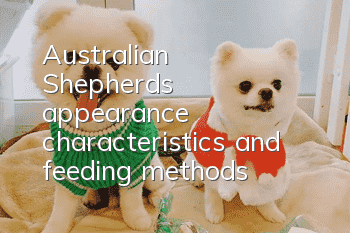Australian Shepherd’s appearance characteristics and feeding methods

The Australian Shepherd, usually referred to as the Australian Shepherd, is a typical working dog. It performs very well in livestock herding and guarding, and is suitable as a loyal partner. It has strong perseverance and can work continuously 24 hours a day. Its body structure is very well-proportioned, and it is a medium-sized dog with well-developed bones and sufficient bone mass. The color of the Shepherd's body is full of personality and diverse! The Australian Shepherd is very focused on work, lively and active, has good body flexibility, and has a Well muscled, but not clumsy. Its hair is medium in length and thick in texture!
1. Appearance characteristics of Australian Shepherd
1.Head
The Shepherd's head gives the impression of being very clean, strong and free of fat. The head and body form a certain proportion. The muzzle is as long as the head. Viewed from the side, the outline of the muzzle is at the same level as the outline of the head. The muzzle is of appropriate size, with a clear stop, tapered shape, and a slightly rounded end! Shepherd Dog The ears are triangular in shape, of medium size, with thick auricles. The base of the ears is set very high and tilts forward. They look like rose ears. Drop ears are considered a disqualification! The top of its head is slightly arched, and the occipital bone is protruding. The length and width of the head are equal! The Shepherd Dog's eyes are almond-shaped, bright and alert, and can be brown, blue, amber or other random combinations of different colors.
2.Rhinoscope
The nose of a black dog is black, while that of a red merle dog is liver-colored. For dogs over one year old, the pink stain should not exceed the nose area by too much, otherwise it will be regarded as a fault!
3.Teeth
The teeth of the Shepherd Dog are well developed, white and neat, the upper and lower teeth are densely arranged, and have a scissor-shaped bite. A protruding mandible is considered a defect. Missing teeth due to traffic accidents or other accidents are not considered defects!
4. Neck
Its neck has well-developed muscles, strong, moderate length, slightly arched, and blends harmoniously with the shoulders. The Shepherd's backline is straight, flat and stable, its hips are slightly sloping, its chest is deep, reaching to the elbows, and has good expandability. Its lower abdomen has a graceful curve and is appropriately lifted. The tail is straight and may be docked or short! The Shepherd's shoulder blades are long and flat, the forearms and shoulder blades are at a 90-degree angle, and the forelimbs are straight and perpendicular to the ground. The dog's thighs are well developed and have strong bones. , slightly oval. The ankles are moderate in length and slightly slanted. The claws are oval and very compact, tightly integrated with the toes. The pads are thick and have good elasticity!
5. Hair and color
The shepherd's hair can be straight or curly. In short, it helps it withstand cold weather well! The amount of its undercoat will also change with the weather, as will the hair on its head, ears and forelimbs. All are short and smooth, withThere is a hint of feathering, in which the male dog is very prominent. The Collie has white hair on its neck, chest and legs. But there shouldn’t be too much white hair on its head, and the area around its eyes must be of appropriate color with sufficient pigment!
6. Pace
The gait of the Australian Shepherd feels very light, relaxed and coordinated. When it speeds up, the center of gravity of its limbs moves closer to the center of the body, while the back remains balanced.
2. Australian Shepherd breeding knowledge
1. Domestication
The owner needs to better manage the dog when raising it, and let it develop a good habit of cleanliness, such as defecating in a fixed place. In addition, owners need to regularly remove dirt from the dog's ears and teeth. This dog's eyes are large, and it is inevitable that foreign matter such as wind and sand will enter. This requires owners to clean its eyes frequently to prevent virus infection.
2. Diet
Parents can decide whether to deworm or vaccinate their dogs based on their dog's physical condition or diet. Epidemic prevention is the most critical step in raising dogs. Under normal circumstances, if a dog moves around after a meal, it means that it wants to rake. This is also a good time to train the dog. The owner should patiently train it to develop a good habit of defecation at a fixed point. Don’t think that it is still young, etc. It will be too late to train it after it grows up, and it may cause a lot of trouble! Therefore, education should start from an early age!
3. Cleanliness
The owner needs to clean the dog's shack every day and disinfect it once a week. At the same time, the food utensils used for eating need to be cleaned one by one. They can be soaked in medicine in advance, which can better achieve the effect of disinfection and sterilization. Owners should also not forget to prepare sufficient drinking water for their dogs!
Guess you like it
Cocker Spaniel, Poodle, Airedale Terrier, Bull Terrier, Gordon Setter
- What is the reason why puppies have a lot of eye droppings?
- Clinical symptoms of orchitis (epididymitis) in dogs
- Why do dogs dig holes?
- What should I do if my dog bites things randomly? How to get rid of my dog’s habit of chewing things!
- How to get your Rottweiler to love nail clipping
- Why does Teddy have his tail docked?
- What are the symptoms of gastroenteritis in dogs?
- What to do if your dog gets skin mites
- Can puppies eat mangosteen?
- Can dogs eat norfloxacin?



